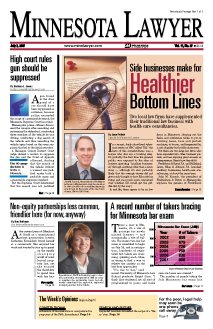 The Minnesota Court of Appeals celebrated its 25th anniversary yesterday.
The Minnesota Court of Appeals celebrated its 25th anniversary yesterday.At an all-day symposium commemorating the event -- held at William Mitchell College of Law -- Judge Harriet Lansing (at right) gave a really nice lunchtime address, aptly titled “The Minnesota Court of Appeals: Twenty-five years of Doing Minnesota Justice.”
Lansing explained that there was a “notable battle” over the whether the state should create an intermediate court. Many influential people opposed it, arguing that it would not provide finality and instead would add another layer of judicial bureaucracy to the appellate process.
Despite the opposition, a constitutional amendment creating the court passed overwhelming in 1982. The first judges were sworn in on Nov. 2, 1983, at the Landmark Center in St. Paul.
Lansing, who was one of those judges, said that the court has met most, if not all, of the goals set out by the people who created it a quarter century ago. To date, the Minnesota Court of Appeals:
- has decided more than 56,000 cases;
- is the final decision maker in 97 percent of cases filed;
- continues to allow oral argument for every litigant who requests it;
- continues to issue written opinions in all cases;
- decides all cases within 90 days of being heard; and
- continues to hear cases all over the state.
The only area the court has struggled in recently has been promptly setting cases on for oral argument. It’s hoped that the recent addition of three more judges to the court will help it attain its goal of completing all cases within six months of filing. Despite that one area, the Court of Appeals has done what it set out to do and has done it well.
“We have earned the right to celebrate 25 years of doing Minnesota justice,” Lansing told the audience.
